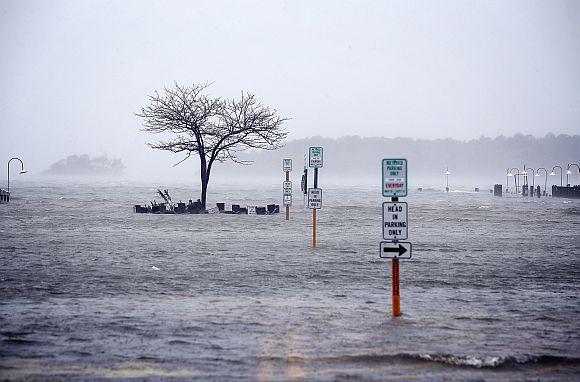
Hurricane Sandy's arrival at America's eastern seaboard has forced the shutdown of mass transit, schools and financial markets, sending coastal residents fleeing, and threatening a dangerous mix of high winds, soaking rain and a surging wall of water up to 11 feet tall.
The monster storm's impact on some 60 million residents was fuelling both apprehension and urgency.
Let's take a look at 10 of the deadliest storms that hit the United States in the past.
Click on NEXT to go further...
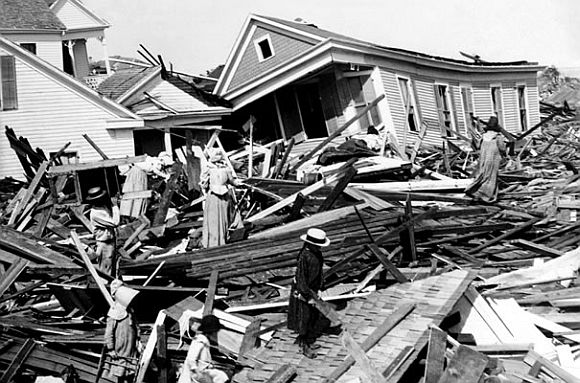
This killer weather system was first detected over the tropical Atlantic on August 27, 1900. While the history of the track and intensity is not fully known, the system reached Cuba as a tropical storm on September 3 and moved into the southeastern Gulf of Mexico on the 5th.
A general west-northwestward motion occurred over the Gulf accompanied by rapid intensification. By the time the storm reached the Texas coast south of Galveston late on September 8, it was a Category 4 hurricane.
This hurricane was the deadliest weather disaster in US history.
Storm tides of 8 to 15 ft inundated the whole of Galveston Island, as well as other portions of the nearby Texas coast.
Toll: 8,000 deaths (estimates range from 6,000 to 12,000) attributed to the storm.
Financial toll: $30 million.
...
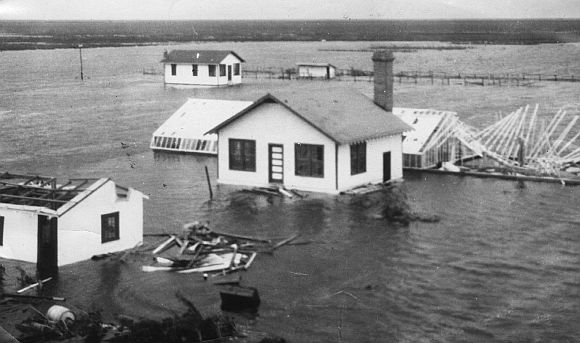
This classic Cape Verde hurricane was first detected over the tropical Atlantic on September 10, 1928, although it was likely formed several days earlier.
This hurricane caused heavy casualties and extensive destruction along its path from the Leeward Islands to Florida.
The worst tragedy occurred at inland Lake Okeechobee in Florida, where the hurricane caused a lake surge of 6 to 9 ft that inundated the surrounding area.
Toll: 1,836 people died in Florida, mainly due to the lake surge. An additional 312 people died in Puerto Rico, and 18 more were reported dead in the Bahamas.
Financial Toll: Damage to property was estimated at $50,000,000 in Puerto Rico and $25,000,000 in Florida.
...

This horrific tropical cyclone formed from the combination of a tropical wave, an upper-level trough, and the mid-level remnants of Tropical Depression Ten.
Katrina brought hurricane conditions to southeastern Louisiana, southern Mississippi, and southwestern Alabama. The Coastal Marine Automated Network (C-MAN) station at Grand Isle, Louisiana reported 10-minute average winds of 87 mph at 0820 UTC August 29 with a gust to 114 mph.
Katrina caused catastrophic damage in southeastern Louisiana and southern Mississippi. Storm surge along the Mississippi coast caused total destruction of many structures, with the surge damage extending several miles inland.
Similar damage occurred in portions of southeastern Louisiana southeast of New Orleans. The surge overtopped and breached levees in the New Orleans metropolitan area, resulting in the inundation of much of the city and its eastern suburbs. Wind damage from Katrina extended well inland into northern Mississippi and Alabama.
The hurricane also caused wind and water damage in Miami-Dade and Broward counties.
Toll: 1200 reported deaths, including about 1000 in Louisiana and 200 in Mississippi
Financial Toll: Estimated at $75 billion in the New Orleans area and along the Mississippi coast
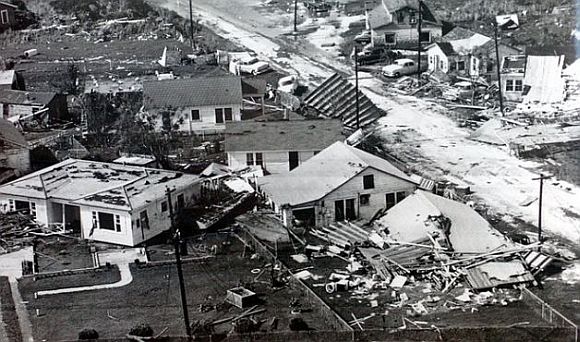
Audrey was first detected over the southwestern Gulf of Mexico on June 24.
No reliable wind or pressure measurements are available from Audrey's core at landfall. The main impact was from 8 to 12 ft storm surges that penetrated as far inland as 25 miles over portions of low-lying southwestern Louisiana.
Toll: The surges were responsible for the vast majority of the 390 deaths.
Financial toll: Damage in the US was estimated at $150 million.
...

This system was first detected east of the central Bahamas on August 29, 1935. A pressure of 26.35 inches measured at Long Key, Florida makes this the most intense hurricane of record to hit the United States and the third most intense hurricane of record in the Atlantic basin (surpassed only by the 26.05 inches in Hurricane Wilma in 2005 and 26.22 inches observed in Hurricane Gilbert in 1988).
Toll: The combination of winds and tides were responsible for 408 deaths in the Florida Keys, primarily among World War I veterans working in the area.
Financial Toll: Damage estimated at $6 million.
...
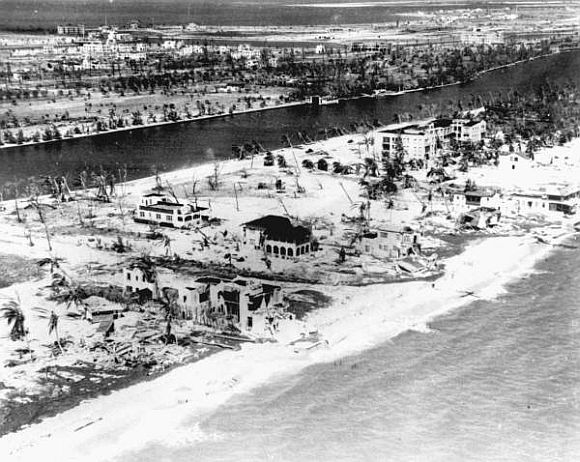
The Category 4 hurricane's eye moved directly over Miami Beach and downtown Miami during the morning hours of September 18, 1926.
This cyclone produced the highest sustained winds ever recorded in the United States at the time, and the barometric pressure fell to 27.61 inches as the eye passed over Miami.
A storm surge of nearly 15 feet was reported in Coconut Grove. Many casualties resulted as people ventured outdoors during the half-hour lull in the storm as the eye passed overhead. Most residents, having not experienced a hurricane, believed that the storm had passed during the lull.
They were suddenly trapped and exposed to the eastern half of the hurricane shortly thereafter. Every building in the downtown district of Miami was damaged or destroyed. The town of Moore Haven on the south side of Lake Okeechobee was completely flooded by lake surge from the hurricane. Hundreds of people in Moore Haven alone were killed by this surge, which left behind floodwaters in the town for weeks afterward.
Toll: 371 dead, over 800 missing and 6,381 injured
Financial Toll: $90 billion (inflation adjusted)
...

Like Hurricane Katrina, the Grand Isle Hurricane caused major flooding throughout New Orleans, although most of the low-lying regions had yet to be developed into the residential zones affected by Katrina's flooding.
Also similar to the circumstances surrounding Hurricane Katrina, aid from the government was slow to arrive in the more devastated areas until news reports began to focus on the hundreds of survivors left homeless and in dire need of basic necessities.
Toll: 350 dead
...
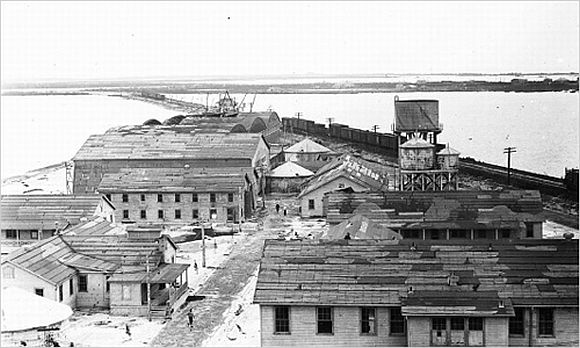
This Category 4 storm ripped through the Florida Keys and intensified once it hit the Florida Straits and the Gulf of Mexico.
Although hurricane-force winds occurred over the Florida Keys and the central and south Texas coast, no reliable wind measurements are available from near the centre.
A storm surge of up to 12 ft inundated Corpus Christi, Texas causing major damage to the coastal areas. A ship moored near the Dry Tortugas measured a pressure of 27.37 inches as the center passed, and based on this, the storm is ranked as the third most intense to hit the United States.
Toll: Estimated at 600 to 900 people. Of these, more than 500 were lost on ten ships that either sunk or were reported missing.
Financial Toll: Damage in the US was estimated at $22 million.
...

Right in the line of fire for Atlantic hurricanes, Galveston was slammed again 15 years after enduring the devastating 1900 hurricane.
In response to that storm, the townspeople built a seawall to protect against future flooding from hurricanes hitting its coast.
Though the new structure held, the entire 300-ft (90 m) beach eroded and became an offshore sandbar, later partially returning as a small beach.
Toll: 275 dead
...

Only six years after the Grand Isle Hurricane struck, another destructive storm hit New Orleans, its winds reaching 145 mph (235 km/h).
Flooding was not as widespread during this storm, but as with Hurricane Katrina, waters from Lake Pontchartrain were forced backward into the city's drainage canals because of a power failure in the drainage pumps.
Most of the storm's casualties occurred in southeast Louisiana, where flooding washed away many of the levees protecting the area.
Toll: 275 dead
Click on NEXT to go further...
...